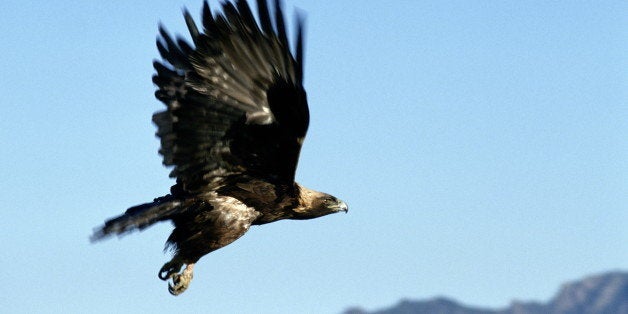
Wind energy proponents are hoping people will look more broadly at the issue and more closely at the reported numbers of a recent U.S. Fish and Wildlife Service study that found wind-energy farms directly caused the deaths of hundreds of eagles since the late 1990s.
The study, published Tuesday, reports that from 1997 until 2012 at least 85 golden eagles and bald eagles were killed by 32 wind-energy installations across 10 states.
"No one takes wildlife impacts more seriously than the wind industry, and while some eagles occasionally collide with turbines at some wind farms, this is not a common occurrence," wrote John M. Anderson, director of siting policy for the American Wind Energy Association, in a blog post responding to the study. "Fatalities of golden eagles at modern wind facilities represent only two percent of all documented sources of human-caused eagle fatalities, while only a few bald eagles have died in collisions in the history of the industry."
Other studies have found that wind farms are responsible for a variety of bird deaths, but ultimately concluded that their avian death toll is negligible when compared to that of other power plants.
One study identified 20,000 avian deaths from wind farms in 2009 but found that in that same year, 330,000 birds were killed by nuclear power plants, and more than 14 million were killed by fossil-fueled power plants.
Eagles, however, are more likely to collide with wind turbines than other birds because they focus their senses on the ground instead of staring ahead, National Geographic reported.
U.S. Fish and Wildlife Service researchers said the new study's results "likely underestimate, perhaps substantially" the number of eagle deaths due to wind turbines, because U.S. wind facilities are not required to report eagle mortalities and the researchers had to rely mainly on voluntary reports and public data.
The study also did not take into account eagle deaths from the Altamont Pass Wind Resource Area (APWRA), a Northern California wind-energy farm located in an area that supports the world's highest-known density of Golden Eagle nesting territories, according to the Golden Gate Audubon Society. Researchers said they did not include the APWRA mortalities because those eagle deaths have been so widely studied and reported already.
The APWRA could be responsible for the deaths of an estimated 40 to 110 golden eagles each year and is "probably the worst site ever chosen for a wind energy project," the regional Audubon Society says. The facility was built in the 1980s, before the deadliness of wind turbines was fully realized.
But building wind farms in eagle-free locations may be easier said than done. The U.S. Fish and Wildlife Service study reported that ideal locations for wind turbines often overlap with both bald eagle and golden eagle habitats. "Golden Eagles, in particular, use open spaces and wind resources similar to those valuable for wind energy facilities," the researchers noted.
The study is one of the first to assess the direct impact of wind turbines on eagle deaths, and the exact number of eagles killed by modern wind facilities remains unclear.
The American Wind Energy Association's Anderson doesn't deny the 85 eagle deaths listed in the report, but he did point to another study from the Journal of Wildlife Management that found golden eagle populations remained stable from 1968 to 2010.
That study's researchers concluded that if the United States continues to develop wind farms at the rates it did from 2008 to 2012, the effects on eagle deaths should be closely watched.
Ultimately, though, environmentalist groups agree that the fate of eagles and all other species is dependent on our commitment to developing alternative sources of energy.
"Most of today's rapidly growing demand for energy is now being met by natural gas and expanded coal-burning power plants, which are this country's single greatest source of the greenhouse-gas emissions that cause global warming," the Audubon Society says on its website. "If we don't find ways to reduce these emissions, far more birds -- and people -- will be threatened by global warming than by wind turbines."

